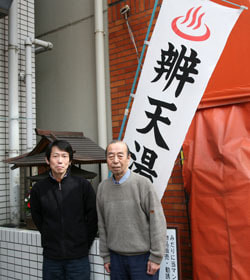
Koichi Kitajima (left) and Kenichi Kitajima (right), the owner and the previous owner of Benten-yu, respectively
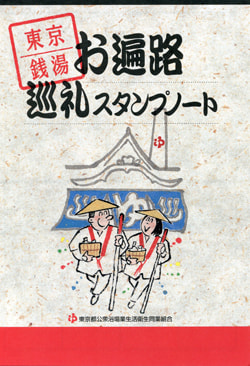
Tokyo Sento Association holds "Sento Ohenro,"a tour of bathhouses in Tokyo. If participants have visited 26 bathhouses, the association awards the "Sento Ohenro Tassei" certificate and the Sento badge to the participants. It is a project to nurture so-called "experts of bathhouses."
We talked with Koichi Kitajima, the owner of Benten-yu (Asakusa-bashi 1-chome), who serves as the chairman of "Taito City Yokujokumiai Rengoukai," or Taito City bathhouse association, and Kenichi Kitajima, the previous owner of Benten-yu.
Q: Could you tell me about a history of Benten-yu? Why is "Benzaiten," or the Goddess of Fortune, enshrined at the entrance?
Kenichi is the third owner, and Koichi is the fourth owner. Although Tsunejiro, the founder from Toyama Prefecture, opened Benten-yu at the current location in the Meiji Period, detailed documents are not left due to the confusion after the war, so there is no exact record.
The Benzaiten was originally enshrined in the neighborhood, but there were fewer places to enshrine it after the war, so people in the neighborhood somehow managed to continue to enshrine it. However, there was nowhere left to enshrine it due to the Road Traffic Law, so Benten-yu took responsibility for enshrining it. Now, buildings stand here, but, in the past, there was a shrine. I think Benten-yu was named after the Benzaiten. (continued in the lower column)
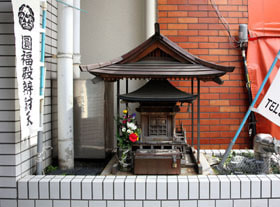
Q: Could you tell me about situations of bathhouses in Taito City? Also, how many customers use Benten-yu per day?
There is still demand for bathhouses in areas, such as Negishi, Matsugaoka and Senzoku, where old houses remain, but the demand declines in the Yanaka area, and the number of closed bathhouses has increased in areas, such as Yanagibashi and Taito, where the number of condominiums has increased.
About 100 customers, including those who use bathing tickets (distributed to elderly people and households on welfare), visit Benten-yu per day. I think, compared to other bathhouses in Taito City, the number is rather small. In areas where there are many households with no bathrooms and many elderly people live, 300 to 400 customers use bathhouses per day.
Q: It seems that non-Japanese residents have increased in this area. What about it?
There was a famous story of foreigners who tried to take a bath without taking off their underpants, but, nowadays, such people scarcely come to bathhouses. Their bathing style is different, so, at first, there were some troubles, but, once they become familiar with the Japanese style, there is no problem. Many foreign backpackers try to lean Japanese, so they communicate with me with gestures and accept what I say. Bathing manners are also illustrated on posters, but some Japanese other than foreigners do not observe the manners. In the past, people took hot water from a bathtub and splashed it on themselves before entering the bathtub. Nowadays, hot water is taken from faucets, but elderly people have a sense that new hot water should not be wasted, so they still take it from the bathtub. (continued in the lower column)
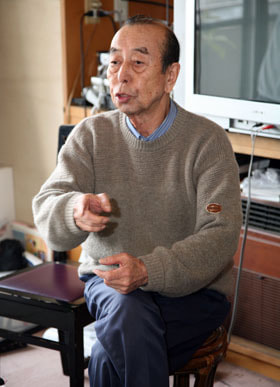
Q: What kind of people use Benten-yu? Also, people say it is important that bathhouses be utilized when disasters occur. What do you think about it?
Although there are many accessory shops in Asakusa-bashi, but most of staff at those shops commute from other places, so they hardly come to the bathhouse. After all, most customers are local people. Customers also come from neighboring Chiyoda and Chuo Cities where bathhouses have been disappearing. Elementary and Junior High Schools students hardly come to the bathhouse.
Although some new bathhouses use tap water, most bathhouses in Taito City use well water. Benten-yu also uses well water for bathtubs and showers, and tap water for rest rooms. We have concluded an agreement about use of the well in times of disasters with Taito City, and conduct a water quality test every other year. Wells do not dry up partly because they are not frequently used. I think, if wells are sunk, they yield more abundant water than in the past. We dig deep in the ground, conduct water quality tests, and use the best quality water. Water qualities differ depending on areas and depths of wells. For example, neighboring Jakotsu-yu (Asakusa 1-chome) uses a well that yields blackish water. Wells in this area yield hard water, so, when it was boiled, calcareous materials called "Gari" adhere to piping, bathtubs and others, which are hard to remove.
Q: How much water is used per day? Also, considering about disasters, such as the Great East Japan Earthquake, do wells have important meanings in the future, don't they?
I have not measured exactly how much water is used per day. Pumping well water is free of charge, but used water is discharged into sewers, so we should pay sewerage charges. The charges are calculated according to operating time of a motor after measuring a pipe width and its amount per square meter and installing a meter.
In the past, when water was cut off in this area, Benten-yu supplied water. Under normal situations, well water is pumped to the roof tank, and then supplied to bathtubs and faucets, but, at that time, water was supplied from faucets before it was pumped to the tank. Although the Great East Japan Earthquake did not affect our operation, we use electricity to pump well water, so, if a blackout occurs, it is difficult to operate and supply water. There are not particular ways of coping with disasters and earthquakes, but some areas have specified ways of coping with them.
Q: Many recent-day bathhouses' "Bandai," or custodian's elevated seat, is placed outside, isn't it? Also, what about nostalgic pictures on bathhouses' walls?
There are a variety of the pictures. The number of old-fashioned Bandai has been decreasing, but it has not disappeared. There are some bathhouses in which inner structures are modified while keeping the Bandai style. Other bathhouses, including Teikoku-yu (Asakusa-bashi 5-chome) are housed in buildings, but the old-fashioned Bandai is still kept. Benten-yu and Tsuruno-yu (Asakusa 5-chome) have counters instead of Bandai. Several bathhouses that have old-fashioned Bandai and paintings of Mt. Fuji still remain.
We ask a famous bathhouse painter in Tokyo to paint pictures on the walls. He is so busy that we have to wait several months to have him paint. Some bathhouses have tiled walls instead of pictures. I recall that pictures are repainted about once in two years. In the past, there were advertising spaces under pictures, so local people could place advertisements on the spaces, and bathhouse painters received the advertising charges. Pictures should be repainted in a day when bathhouses are closed, so they work very quickly. Instead of removing old pictures, new pictures are pained over the old ones. We sometimes specified subjects of pictures, but, basically, we leave subjects to them. I think most subjects are Mt. Fuji because it soothes customers' feelings, and represents Paradise. It might be a remnant of mountain worship, but Mt. Fuji should not necessarily be pained in the direction of Mt. Fuji.
Q: What about business hours, regular holidays and the present bathing charge?
Business hours are not as punctual as it used to be, but bathhouses in this area usually open at 3:00 p.m. and close around midnight. Benten-yu opens at 3:30 p.m., and closes at 11:30 p.m. Following a notification issued by the Sento Association head office, bathhouses open in the morning of New Year's Day. Tsubame-yu (Ueno 3-chome) regularly opens early every morning, but closes at 8:00 p.m., because the nighttime population is small, and many people live in condominiums. Some bathhouses have regular holidays while others do not. There are no standard rules. Many bathhouses close on Mondays because many customers used to come to bathhouses on Saturdays and Sundays. Benten-yu closes two Mondays a month. We adjust holidays so that Benten-yu and other bathhouses in this area do not close on the same day.
A charge for bathing, compared with that in the past, has gone up. A committee consisting of the Tokyo metropolitan government and key figures decide the charge every year. Regarding bathing tickets distributed by municipalities, the system varies according to each ward.(continued in the upper right column)
In Taito City, 20 support tickets per month are distributed to elderly people, and they add 50 yen to the ticket when entering bathhouses. The system is very helpful for both customers and bathhouses.
Q: Could you tell me about the structure of bathtubs? Are there still nostalgic sweet flag and yuzu baths?
At Benten-yu, the water temperature is set to 43 degrees Celsius, but the actual temperature is 41 to 45 degrees Celsius. The temperature is same for men's and women's sections. Based on a guidance of the public health center, hot water should spill out when customers enter bathtubs. It is a practice that can be traced back to the time when there was no filtering equipment. When water is added to hot water, dirt on the surface of hot water flows out.
Nowadays, sweet flag and yuzu baths are offered as services to customers, but those baths are also recommended by the Sento Association head office, so we do so. Some bathhouses in other areas offer a variety of baths, for example, by cooperating with provincial municipalities and using farm products that are difficult to market.
Q: What about the present and future approaches? I think it might be a good opportunity for students to have so-called "naked communication" with one another if you invite them to the bathhouse.
I think bathhouses should have an enough capacity to do other things. Otherwise bathhouses end up in failure. Now, the association has been discussing an approach to turning bathhouses into health-promotion-center-type bathhouses and receiving subsidies from wards or the Tokyo metropolitan government. Also, Bentan-yu can be rented for private use by care homes. It is an attempt initiated by small and medium companies in Nagoya, but major companies also start to enter the business. Benten-yu is the first bathhouse to do the attempt in Taito City. Not so many bathhouses make this kind of attempt, but those companies said they want to do the same thing at facilities, such as a health resort and fitness club, so the number of competitors will increase.
I also heard that Jakotsu-yu (Asakusa 1-chome) regularly holds rakugo performances to receive subsidies. Benten-yu also once made a stage in the women's section, and held a rakugo performance though customers could not see it while soaking themselves in the bathtub. Incomes of bathhouses are determined by how many customers come to the bathhouses and how much they pay, but customers can use facilities, such as a fitness club, as many times as they like, so those facilities are powerful competitors. Those facilities take young customers away from bathhouses, and foreigners who do not have a custom of soaking in a bathtub might think that the cheaper the better.
In the past, there was an activity in which school children experienced jobs in a bathhouse, but there were liability issues regarding extramural activities, and, these days, children feel uncomfortable taking off clothes in front of others, so such activities were discontinued. In Taito City, there is no bathhouse that makes an arrangement with elementary schools, but, in other wards, some bathhouses invite elementary school students to events, and hold stamp rallies in which parents and children take a bath. If communities and teachers do not call for, an approach from the bathhouse side does not work out. In Taito City, there is a considerable disparity in the number of children among areas, so it is difficult to hold an event at the same time. (continued in the lower column)
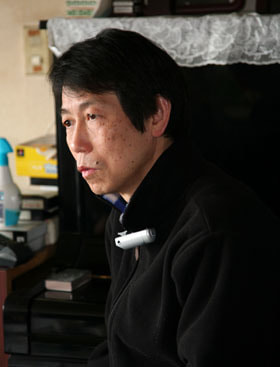
Q: Are there some policies for maintaining bathhouses in Tokyo? Is it difficult to change the operation style in order to compete with large health resorts?
I am advised to improve services and provide shampoo and conditioner so that customers do not have to bring them. Although Benten-yu provides shampoo and conditioner for a charge, some bathhouses offer them for free. I'd appreciate it if customers bring towels, soaps and shampoo for themselves. Nowadays, some customers come to the bathhouse as if they come to a health resort or super sento. For example, they ask, "Do I have to pay in advance?" or "Do you have towels and shampoo?" when they enter the bathhouse.
Although it is rare in Taito City, some bathhouses, such as Asahi-yu (present-day Aqua Place Asahi, Asakusa 5-chome), are remodeled to facilities like a super sento.
Q: At what rate have bathhouses been closed? Also, are there people who newly open bathhouses?
In Taito City, one bathhouse per year has closed in recent years. I think there are no people who newly open bathhouses because it is hard work and requires money and workers but bathhouses are not profitable. The reason Benten-yu continues to operate is that it takes root in the community, and that we'd like to contribute to the community. Although it is said that there is a problem of a lack of successors, if bathhouses are profitable, successors must have appeared.
Q: What do you think about the future of bathhouses?
Some owners of bathhouses have carried out a diversified business operation. Any trade, such as a fish or vegetable store, has difficulty to independently operate business that is rooted in the community. A fish store in the neighborhood can pay by providing fish to restaurants other than local people. The same applies to Benten-yu. Since it is difficult to make enough income from the bathhouse only, Benten-yu was reconstructed into a tall building when the third owner operated it so that extra incomes can be earned from an underground parking lot. In the present, Benten-yu is a family-run bathhouse, but is in so much financial difficulty that we might not pay wages after covering necessary expenses, so I think it will be impossible to run the bathhouse even if my son will succeed the bathhouse.
There is no longer live-in employee, but, in the prewar period when the third owner was an elementary school student, there were a head clerk and student boarders. Coal was used for fuel in the past, but after it became expensive and could not be used, we picked up wood, sawdust and wood shavings at a lumber mill in Fukagawa, and brought them back as fuel by a two-wheeled wooden cart. Nowadays, approximately half of bathhouses use gas for fuel. Other bathhouses use heavy oil or burns wood and scrap wood in a traditional way. Several bathhouses, including Benten-yu, use electricity to heat bathwater. Although some bathhouses make use of sunlight from an ecological point of view, enough energy cannot be generated by sunlight only, so it is used together with gas. The cheapest way is to use a mixed burning boiler that can burn all sorts of materials. We used to take scrap wood for fuel, which could be obtained when houses were torn down. Recently, it has been difficult to obtain wood. Also, there is no firm that asks us to burn old wooden pallets forklifts use. Some bathhouses in the neighborhood used to burn chopped wooden pallets in mixed burning boilers, but current pallets are made of resin, so they cannot be burnt.
Q: What do you think about the meaning of bathhouses?
There are currently 761 bathhouses in Tokyo, but the "Ordinance regarding standards of locations of bathhouses and hygiene measures taken by them" (the Tokyo metropolitan government) stipulates that more than two bathhouses should not be built within a distance of 200 meters in special districts and 300 meters in cities, towns, and villages. Many elderly people prefer to come to bathhouses and soak in large bathtubs even if their houses have bathrooms because they have been familiar with bathhouses. A bathhouse is a space for communication, so the same people come to the bathhouse at the same time. They come to the bathhouse according to their life rhythms, so they become acquainted with one another in the course of nature. For elderly people, a bathhouse is an important space for communication. I heard that a person called the ward office because he was in trouble after a nearby bathhouse closed. (continued in the next page)

Koichi Kitajima (left) and Kenichi Kitajima (right), the owner and the previous owner of Benten-yu, respectively

Tokyo Sento Association holds "Sento Ohenro,"a tour of bathhouses in Tokyo. If participants have visited 26 bathhouses, the association awards the "Sento Ohenro Tassei" certificate and the Sento badge to the participants. It is a project to nurture so-called "experts of bathhouses."








